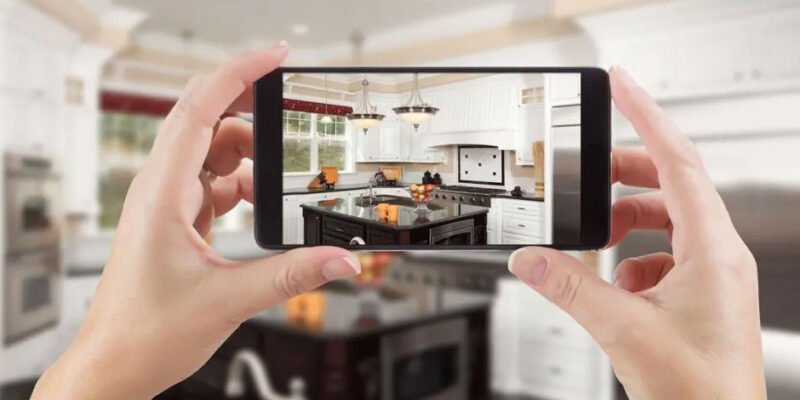Introduction
In the realm of real estate, the power of virtual tours has surged forward, accelerated both by technological advancements and the impact of a global pandemic. Recent statistics reveal that a significant 61% of prospective home buyers consider virtual property tours to be the most invaluable technological tool at their disposal. In comparison, traditional options like high-quality photographs (51%) and accurate listing information (58%) take a backseat. The allure of virtual tours lies in their ability to offer potential buyers an immersive experience that surpasses static imagery, allowing them to develop a profound connection with a property. This guide delves into the intricacies of crafting captivating virtual tours, paving the way for potential buyers to genuinely “earn their freedom” by envisioning their dream abode.
1. Selecting the Appropriate Equipment
The journey of creating an exceptional virtual tour doesn’t necessitate a substantial investment in high-priced equipment. Remarkably, even an affordable fisheye lens adapter for your smartphone can suffice, producing wide-resolution photos that capture the essence of a space. However, for optimum quality, upgrading to a full-fledged DSLR camera is recommended. Though these cameras can be pricier, ranging upwards of $3,500, they offer unparalleled results.
Camera Options
- Asteroom 3D Tour Kit: Catering to those on a budget, this kit employs a smartphone’s camera to construct digital panoramas within spaces up to 3,000 square feet. The included rotator automates camera rotation, complemented by a fisheye lens that expands image perspectives. Priced at $109.99, it presents an economical choice.
- Insta360 ONE RS: While primarily designed as an action camera, the ONE RS performs splendidly for real estate virtual tours, boasting a 360-degree Horizon Lock feature. With the capability to capture 21-megapixel 360 photos and dual 1-inch sensors for enhanced low-light processing, it stands as a versatile option. Opting for the virtual tour package, priced at $859.99, includes essential accessories.
- Matterport Pro2: Representing the gold standard, the Pro2 camera shines with its 134-megapixel capacity and 3D precision. Sporting 4K resolution and enduring battery life, it’s particularly appealing for busy real estate agents catering to discerning clients. However, its $3,395 price tag might pose a hurdle for newcomers.
The selection process extends to acquiring a tripod capable of controlled rotation to capture all room aspects seamlessly. While several cameras come bundled with tripods, those using personal DSLRs must ensure a suitable tripod investment.
2. Opting for Virtual Tour Software
The pivotal juncture arrives when you must choose software to harmonize your captured images into a cohesive virtual tour. Multiple options exist, each offering distinct advantages:
- Zillow 3D Home app: Ideal for smartphone users, this app facilitates swift creation of 3D tours directly from your phone. Nevertheless, its primary purpose lies in integrating 3D tours onto the Zillow platform, making it less suitable for broader sharing.
- Klapty: Compatible with both phone and 360 camera photos in JPEG format, Klapty offers versatility. It enables the addition of 2D photos, information hotspots, and more to augment your tour. The service is free, with Pro and Gold tiers available for enhanced features.
- Matterport: Aligning with Matterport cameras, this software proves a natural fit. While a free plan exists, its functionality is limited. A $9.99 monthly subscription permits widespread tour sharing, along with the option to include a schematic floor plan for $19.99.
3. Strategizing Your Photo Composition
Efficient planning is the foundation of any successful endeavor. Similarly, meticulously charting your virtual tour’s path and camera placement within each room is critical. Central positioning within a room yields the most comprehensive results, although asymmetrical spaces might necessitate adaptive placement. A logical route simulation mirrors the experience of physically exploring the home, ensuring a seamless journey for the viewer. Cohesion matters; transitions between rooms should be coherent and intuitive, enhancing the tour’s overall fluidity.
4. Preparation and Staging
Preparing your property for the virtual spotlight is akin to a theatrical production, necessitating meticulous arrangements. Minimalism is key—urge homeowners to declutter and clear spaces. Storage spaces and closets, frequently showcased in virtual tours, should be uncluttered. Inhabited homes necessitate thorough cleaning, including windows, trim, floors, and fireplaces, ensuring a spotless presentation. The option of staging emerges—while personal opinions vary, consider services like iStaging or roOomy for virtual staging, sidestepping the complexities of physical redecoration.
5. Equipment Calibration and Lighting
On the day of photography, calibrate equipment, angles, and lighting to ensure impeccable results. Balance your tripod to prevent skewed or distorted photographs. Adjust for any irregularities in the property, such as warping floorboards. Evaluate lighting in each room, supplementing with additional sources if needed. Eliminate unwanted reflections from mirrors or windows, ensuring a clear perspective. Achieving visual excellence enhances the final outcome.
6. Capturing and Compiling
The pinnacle of your efforts lies in capturing photographs that encapsulate the essence of the property. Maintain adherence to your checklist, capturing multiple shots in each room for insurance. Post-photo collection, proceed to upload the images to your chosen software. While navigation varies, these programs often offer the opportunity to embellish tours with music, room descriptions, and interactive elements—components that enrich the user experience.
Benefits of Virtual Tours for Real Estate
The merits of virtual tours extend beyond aesthetics, offering a plethora of advantages:
- Safe Exploration: Virtual tours enable buyers to explore properties without physical presence, an invaluable asset given the lingering concerns post-pandemic.
- Efficient Time Management: Agents can economize time as virtual tours reduce the need for in-person showings.
- Enhanced Buyer Engagement: Well-informed buyers, having interacted with the home through virtual tours, exhibit heightened interest and potential for higher offers.
- Increased Property Value: Research suggests that homes with virtual tours command higher prices—3% more for lower-priced homes and 1.6% more for higher-priced homes.
Conclusion
Embarking on the journey of crafting captivating virtual tours requires dedication, but the fruits of your labor are substantial. Sellers witness augmented overall earnings, while agents curtail time spent on showings, catering to genuinely interested buyers. In an evolving landscape, specializing in virtual tours positions you at the vanguard, granting a competitive edge as technology assimilates into the mainstream real estate sphere.
















Comments